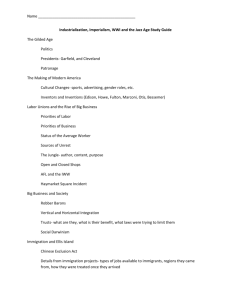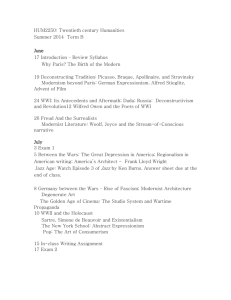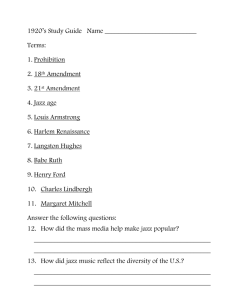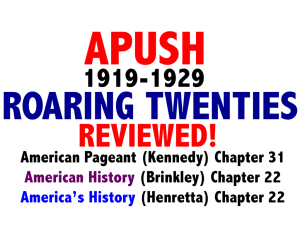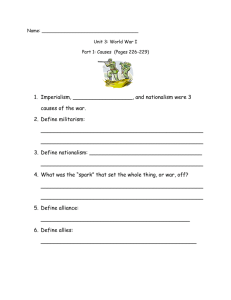CH 31 Notes
advertisement
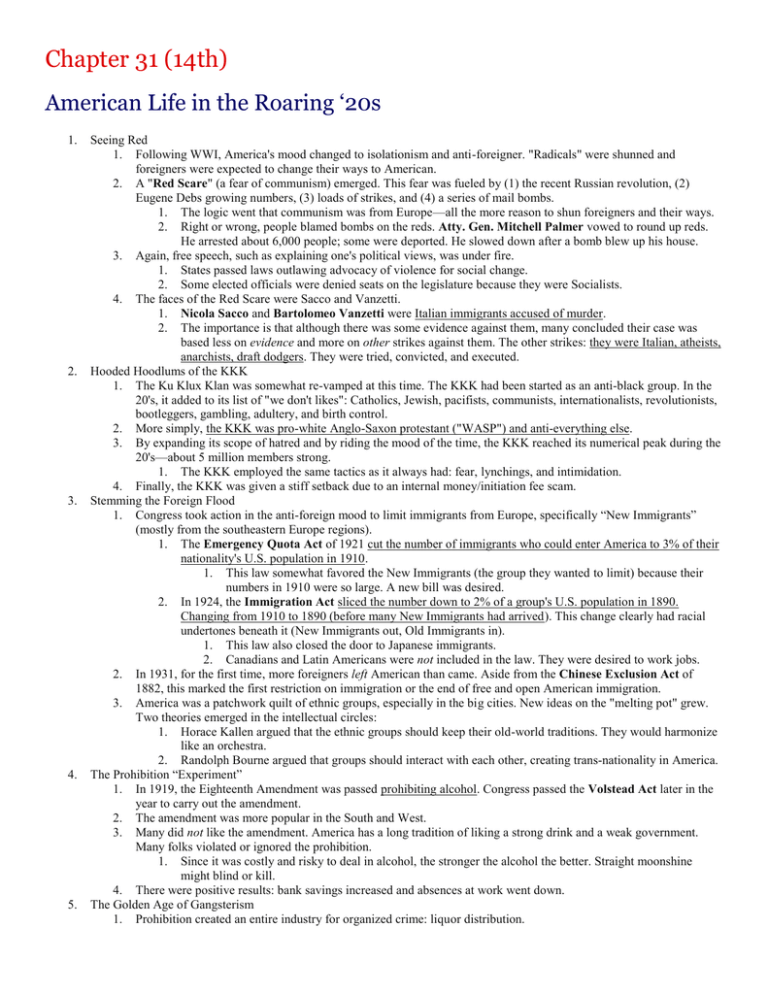
Chapter 31 (14th) American Life in the Roaring ‘20s 1. 2. 3. 4. 5. Seeing Red 1. Following WWI, America's mood changed to isolationism and anti-foreigner. "Radicals" were shunned and foreigners were expected to change their ways to American. 2. A "Red Scare" (a fear of communism) emerged. This fear was fueled by (1) the recent Russian revolution, (2) Eugene Debs growing numbers, (3) loads of strikes, and (4) a series of mail bombs. 1. The logic went that communism was from Europe—all the more reason to shun foreigners and their ways. 2. Right or wrong, people blamed bombs on the reds. Atty. Gen. Mitchell Palmer vowed to round up reds. He arrested about 6,000 people; some were deported. He slowed down after a bomb blew up his house. 3. Again, free speech, such as explaining one's political views, was under fire. 1. States passed laws outlawing advocacy of violence for social change. 2. Some elected officials were denied seats on the legislature because they were Socialists. 4. The faces of the Red Scare were Sacco and Vanzetti. 1. Nicola Sacco and Bartolomeo Vanzetti were Italian immigrants accused of murder. 2. The importance is that although there was some evidence against them, many concluded their case was based less on evidence and more on other strikes against them. The other strikes: they were Italian, atheists, anarchists, draft dodgers. They were tried, convicted, and executed. Hooded Hoodlums of the KKK 1. The Ku Klux Klan was somewhat re-vamped at this time. The KKK had been started as an anti-black group. In the 20's, it added to its list of "we don't likes": Catholics, Jewish, pacifists, communists, internationalists, revolutionists, bootleggers, gambling, adultery, and birth control. 2. More simply, the KKK was pro-white Anglo-Saxon protestant ("WASP") and anti-everything else. 3. By expanding its scope of hatred and by riding the mood of the time, the KKK reached its numerical peak during the 20's—about 5 million members strong. 1. The KKK employed the same tactics as it always had: fear, lynchings, and intimidation. 4. Finally, the KKK was given a stiff setback due to an internal money/initiation fee scam. Stemming the Foreign Flood 1. Congress took action in the anti-foreign mood to limit immigrants from Europe, specifically “New Immigrants” (mostly from the southeastern Europe regions). 1. The Emergency Quota Act of 1921 cut the number of immigrants who could enter America to 3% of their nationality's U.S. population in 1910. 1. This law somewhat favored the New Immigrants (the group they wanted to limit) because their numbers in 1910 were so large. A new bill was desired. 2. In 1924, the Immigration Act sliced the number down to 2% of a group's U.S. population in 1890. Changing from 1910 to 1890 (before many New Immigrants had arrived). This change clearly had racial undertones beneath it (New Immigrants out, Old Immigrants in). 1. This law also closed the door to Japanese immigrants. 2. Canadians and Latin Americans were not included in the law. They were desired to work jobs. 2. In 1931, for the first time, more foreigners left American than came. Aside from the Chinese Exclusion Act of 1882, this marked the first restriction on immigration or the end of free and open American immigration. 3. America was a patchwork quilt of ethnic groups, especially in the big cities. New ideas on the "melting pot" grew. Two theories emerged in the intellectual circles: 1. Horace Kallen argued that the ethnic groups should keep their old-world traditions. They would harmonize like an orchestra. 2. Randolph Bourne argued that groups should interact with each other, creating trans-nationality in America. The Prohibition “Experiment” 1. In 1919, the Eighteenth Amendment was passed prohibiting alcohol. Congress passed the Volstead Act later in the year to carry out the amendment. 2. The amendment was more popular in the South and West. 3. Many did not like the amendment. America has a long tradition of liking a strong drink and a weak government. Many folks violated or ignored the prohibition. 1. Since it was costly and risky to deal in alcohol, the stronger the alcohol the better. Straight moonshine might blind or kill. 4. There were positive results: bank savings increased and absences at work went down. The Golden Age of Gangsterism 1. Prohibition created an entire industry for organized crime: liquor distribution. 2. 6. 7. 8. 9. Gangs emerged and staked out their territories for liquor and their accompanying "speakeasy" bars, gambling, narcotics, whore houses, and extortion money. 3. Chicago led the gang world. About 500 gangsters were murdered in the 20's in Chicago. Arrests were few and convictions were rare since gang members would not rat out others. 1. "Scarface' Al Capone was the biggest and the baddest. Bloodshed and murder followed his armor-clad, bulletproof windowed car through Chicago. The feds named him "Public Enemy Number One." The "Gmen" never got him for the dirty stuff; they did jail him in Alcatraz for tax evasion. 2. By 1930, the estimate of gang income was between $12 and $18 billion—several times the income of the Washington D.C. government. 4. Gang violence/extortion hit headlines in 1932 when Charles Lindbergh's baby was kidnapped for ransom. The baby was soon found murdered. Congress passed the "Lindbergh Law" making interstate kidnapping punishable by death. Monkey Business in Tennessee This content copyright © 2010 by WikiNotes.wikidot.com 1. Education began to change from rote memorization to more hands-on learning. This was the idea of progressive education John Dewey who advocated "learning by doing" and "education for life." 2. Science made gains. Rockefeller Foundation funded a health drive that nearly eliminated hookworm which mostly struck the poor. Nutrition and health care extended the life expectancy from 50 years in 1901 to 59 years in 1929. 3. Scientists butted heads with traditionalists in the 20's over "Scopes Monkey Trial" - Darwin's theory of evolution. 1. Fundamentalists believed in a literal reading of the Bible. They'd grown in numbers, especially in the "Bible Belt" of the South. 2. Tennessee passed a law banning teaching evolution in public schools. A young biology teacher, John T. Scopes broke this law and taught evolution. 3. Dayton, TN became a national stage for the first evolution vs. creation showdown. Big-name lawyers led both sides: the evolution side was argued by Clarence Darrow, presidential candidate William Jennings Bryan argued the creation side. 1. Bryan was passionate, a Bible expert and expert speaker. Darrow was an expert trial lawyer and likely got the better of Bryan. Perhaps the most famous "gotcha" point came when Darrow got Bryan to comment on Jonah being swallowed by a whale. Darrow then said the Bible quotes a "great fish," and not a whale. 2. The trial itself was almost a non-factor—Scopes had broken the no-evolution law. He was convicted and given a slap-on-the-wrist. 3. Stress & passion of the case literally led to Bryan's death from a stroke only five days afterward. 4. Fundamentalism may have gained a victory in that, through mocking, their faith was strengthened even more. And, their numbers continued to grow, especially with Baptists and the new Church of Christ. The Mass-Consumption Economy 1. After the immediate post-war recession, the 1920's generally enjoyed a robust economy. Treasury Sec. Andrew Mellons low-tax policies helped encourage growth. 2. Machinery got better and ran on cheap energy. 1. The business period was personified by Henry Ford. He perfected the assembly line at his Rouge Rive Plant and could produce a new car every 10 seconds. Ford-style mass production was then applied to other industries, lowering costs, and starting mass consumption. 3. To sell tons of new stuff, new advertising techniques were needed. Ads began to employ persuasion and sex appeal. 1. The ad-master was Bruce Barton. He wrote a best-seller, The Man Nobody Knows. That man was Christ, whom Barton said was the best advertiser ever and others marketers would do well to follow his steps. 2. People began to buy things they didn't know they'd needed or wanted, until they saw the ad. Folks followed new (and dangerous) buying techniques…they bought (1) on the installment plan and (2) on credit. Both ways were capable of plunging an unsuspecting consumer into debt. 4. The growing mass media, like newspapers, magazines, and infant radio, made America more homogeneous, more the same from coast-to-coast. This was great for mass consumption. 5. Mass media helped sports grow in popularity. Baseball was the king of American sports with heroes like Babe Ruth. It was now practical to follow your team on a daily basis, home or away. Boxing was popular, with champ Jack Dempsey. Horse racing was the second most popular sport by attendance. Putting America on Rubber Tires 1. Americans took European know-how and further developed the gasoline engine. 2. Frederick Taylor promoted efficiency in production. He would put the stopwatch on a worker then orchestrate his movements to eliminated wasted movement and quicken his time. It was effective as workers became very effective (though they were little more than machine parts). 3. Early moguls in the automobile industry were Henry Ford and Ransom E. Olds (the Oldsmobile). 4. These cars were unreliable—a driver would have to also be half mechanic. But, they were inexpensive, especially Ford's Model T. When Ford switched to the Model A, the assembly line technique made the Model A affordable for practically any working person. 1. When stock market crashed in 1929, 26 million registered cars—1 car for every 4.9 people America. The Advent of the Gasoline Age 1. 2. 10. 11. 12. 13. Cars created 6 million new jobs and quickly became America's number one mode of transportation. Cars brought fundamental changes to America: 1. Roads were now needed—there was a boom in paving and cars' accompanying gasoline industry started and mushroomed. 2. There were social changes as well. Cars brought independence to young people who "dated" in them and America began to reshape itself by spreading out into suburbs. There were many crashes too. By 1951, a million people had died in car crashes—more than all the wars combined. Humans Develop Wings 1. The gas engine also led to airplanes. In Orville and Wilbur Wright man flew for the first time on December 17, 1903 for 12 seconds at Kitty Hawk, N.C. 2. Airplanes grew as heard spread. Many first saw a plane when a stunt flier would barnstorm their town or county fair. 3. Planes were used minimally in World War I—mostly for recon (spying), dog fighting each other, & crude bombing. 4. After WWI planes really got going. They were used for air mail. The first transcontinental airmail route started from New York to San Francisco in 1920. 5. America got a hero when Charles Lindbergh was the first to fly solo across the Atlantic Ocean in 1927. It took him 33 1/2 hours; he won a $25,000 prize, and instantly became a celebrity. 1. Lindbergh was sort of represented the anti-Jazz Age. Whereas many young people were living the high life of fast cars, illegal booze, jazz, nightclubs, "petting parties", Lindbergh was traditional, wholesome and shy. It was said that for a brief moment, the Jazz Age crowd paused their party and tipped their glasses to Lindbergh's accomplishment. The Radio Revolution 1. Guglielmo Marconi invented wireless telegraphy in the 1890's. His invention was used in WWI. The beep-beep radio would soon give birth to voice radio. 2. The first major radio broadcast was made by KDKA it Pittsburgh. They broadcast the results of Warren Harding’s presidential victory. 1. Radio spread out from being local, to powerful national shows that often drowned out the local stations. Entrepreneur Powel Crosley's station sent out 500,000 watts (10 times the limit today) and could be reached nearly anywhere in the U.S. 3. Like the car, the radio also changed society. 1. Radio standardized or homogenized Americans in a way never before possible—everyone could hear the same news at exactly the same time. 2. Whereas the car scattered people, the radio drew them back to their homes. Sitting as a family listening to the radio was the norm. Popular shows were "Amos 'n' Andy. 3. Radio was a new and powerful medium for advertisers as well. They sponsored shows like the "A&P Gypsies" and the "Eveready Hour." 4. It was even easier for sports fans to follow their teams—sports grew even more in popularity. 5. Politicians had to adjust to the new media as well. Hollywood’s Filmland Fantasies 1. Thomas Edison helped invent/develop the "picture show" (movies). 2. Largely considered the first movie was The Great Train Robbery in 1903. The first full-length movie was made in 1915 by D.W. Griffith called The Birth of a Nation. It dealt with the Civil War and Reconstruction and was controversial because it seemed to glorify the KKK. Technically, though, it stunned viewers with its battle scenes and ability to draw out emotions on a personal level. 1. After viewing the movie, Pres. Woodrow Wilson said it was like writing "history with lightning." 3. Hollywood became the movie headquarters with its sunny climate. Early films often featured nude women and "vamps" (female vampires) until criticism clothed things. 4. Movies really took off during WWI as many propaganda shorts were created. 5. The Jazz Singer starring Al Jolson in 1927, a "minstrel" movie with white men dressed as black men, was the first "talkie" (movie with sound). 6. Movies quickly became America's foremost form entertainment. Early movie stars like Charlie Chaplain, Douglas Fairbanks, and Mary Pickford quickly emerged. 7. There were critics of radio and the movies. They said it turned America away from grandma's story-telling to mere clown-shows. Still, the times had changed for good. The Dynamic Decade 1. By the census of 1920, for the first time, more Americans lived in urban areas than in rural areas. This red-letter year marked a teetering point in American history socially—the change from an agrarian to an urban society. 2. There were many social changes during the 20's. The decade marked the break from old-to-new, from traditional-tomodern. This break often came with culture clash (the Scopes Monkey Trial is a great example). 1. Margaret Sanger promoted birth-control for women. The National Women's Party emerged in 1923 with the ambition of getting an Equal Rights Amendment passed to the U.S. Constitution. 2. Religion was watered-down too. "Modernists" pushed back at Fundamentalists. Modernists viewed God as an old chum, as opposed to the traditional view that man was a born sinner and in need of forgiveness through Christ. 3. The young "Jazz Age" set of "flaming youth" shocked the older crowd. The young modern women in the 20's, the "flappers" were the worst: 1. They dressed scantily and danced "dirty" to the Charleston. 2. They drank booze, bobbed their hair short, courted boys in motorcars, and openly spoke of sex. 3. It was popular to read of Sigmund Freud's psychological theories (always involving sex and violence). Freud said sexual repression led to many ills, mental and physical. Thus, sexual gratification was needed for both types of health. 3. Jazz came on in a big way during the 20's (so that F. Scott Fitzgerald coined the term the "Jazz Age"). 1. Jazz pioneers were W.C. Handy with his Memphis blues style, "Jelly Roll" Morton, and "Joe" King Oliver. Jazz was mostly started by black artists, but white performers got most of the profits. 4. Black pride emerged, largely in the cities. 1. Poet Langston Hughes penned the voice of black America. 2. Marcus Garvey founded the United Negro Improvement Association to re-locate blacks to their native homeland. They also sponsored black enterprises to try and keep blacks' money in blacks' hands. 1. Garvey's enterprises usually failed and he was jailed for mail fraud. The sense of pride he helped create remained and helped later start the Nation of Islam (Black Muslim) movement. 14. Cultural Liberation 1. The 1920’s were also a turning point in literature. The Victorian era writers had died: Henry James, Henry Adams, and William Dean Howells. There were a few popular writers, especially Edith Wharton and Willa Cather (who wrote plainly about life on the Plains). 2. The new writers were from broad backgrounds (not just New England Protestants) and they were very good. 1. H.L. Mencken used wit & biting criticism to jab almost every aspect of society in his American Monthly. 2. F. Scott Fitzgerald was the de facto spokesman for the Jazz Age (his term). He gained fame with This Side of Paradise (partying college-kids) and then his best work The Great Gatsby (a ruined WWI vet). His stories, along with his life and wife Zelda, described the period's glamour and senselessness. 3. Theodore Dreiser wrote in the ugly form of a realist (not a romantic) in An American Tragedy. It told of a pregnant woman murdered by her socially ambitious lover. 4. Ernest Hemingway wrote The Sun Also Rises (young adults partying in Paris, Spain) and A Farewell to Arms (young officer fleeing war, seeking love). 1. Roughly based on his own life, both stories showed the empty, hollow lives of young adults. Hemingway became the voice of the "Lost Generation"—those who'd gone to WWI with Wilsonian ideals, only to become disillusioned and ruined by the realities of war. 5. Sherwood Anderson wrote Winesburg, Ohio which dredged the insides small-town America. 6. Sinclair Lewis depicted small-town America in Main Street and 20's materialism/consumerism in Babbitt. 7. William Faulkner wrote hauntingly about the Southern experience in novels such as The Sound and the Fury, As I Lay Dying, and Absolom, Absolom! His books sometimes stunned or confused readers with the new, choppy "stream of consciousness" writing technique. 8. Poetry cut new paths too, led by Ezra Pound and T.S. Eliot with his poem "The Waste Land." Robert Frost wrote of New England ("The Road Not Taken"). And e.e. cummings experimented with the typeset, diction, and punctuation—his poems sounded different but also looked different, adding to their effect. 9. Eugene O'Neill was one of America's greatest playwrights. Plays like "Strange Interlude" which meddled with Freudian ideas of sex. 3. In New York there was a "Harlem Renaissance", an outpouring of African-American art and culture. It was led by writers Claude McKay, Langston Hughes, and Zora Neale Hurston. And also by jazz musicians Louis Armstrong and Eubie Blake. 4. Architecture, perhaps the most symbolic of the changing society, mixed art and science in a very tangible way. 1. Frank L. Wright was an understudy of Louis Sullivan (earlier Chicago skyscraper fame). Wright stunned people with his use of concrete, glass, and steel and his unconventional theory that “form follows function.” 2. The crowned king of skyscrapers was the Empire State Building, with its ultra modern "Art Deco" style, completed in 1931. 15. Wall Street’s Big Bull Market 1. Always the prelude to recession or depression, there was too much speculation in too-risky areas during the 20's. 1. A Florida land boom shot prices on sunny property through the roof. Then a hurricane dealt reality and the land boom went bust in 1926. 2. Stock market was speculator's paradise in the 20's. Desires to get rich quick on rising stock prices created a "buy-now" feeling. This is turn, drove the market higher, & built on that buy-now feeling, artificially. 1. Worse, many people bought "on margin", - they bought with borrowed money. Usually 10% was paid up-front, 90% borrowed. Meaning wild profits if stock went up, wild debt if it drops. 2. This type of structure was like building a house of cards, it could not stand forever. 2. The federal government tried to get their financial house in order when Congress passed the Bureau of the Budget. 1. Sec. of Treasury Andrew Mellon disliked the high taxes leftover from WWI. 1. He felt they forced the rich to put their money in tax-exempt securities, not in factories. His idea, still around today, said that in desiring more tax revenue through high taxes, the higher rate cripples the economy and actually leads to less revenue for the government. 2. Congress did ease the tax burden on the rich and the economy did boom during the 20's. He also succeeded in lowering the national debt. 3. If there is such a thing as a bad side to prosperity, it’s simply that profits enabled people to give in to their greed and over-speculate in risky businesses—a main cause of the Great Depression.
